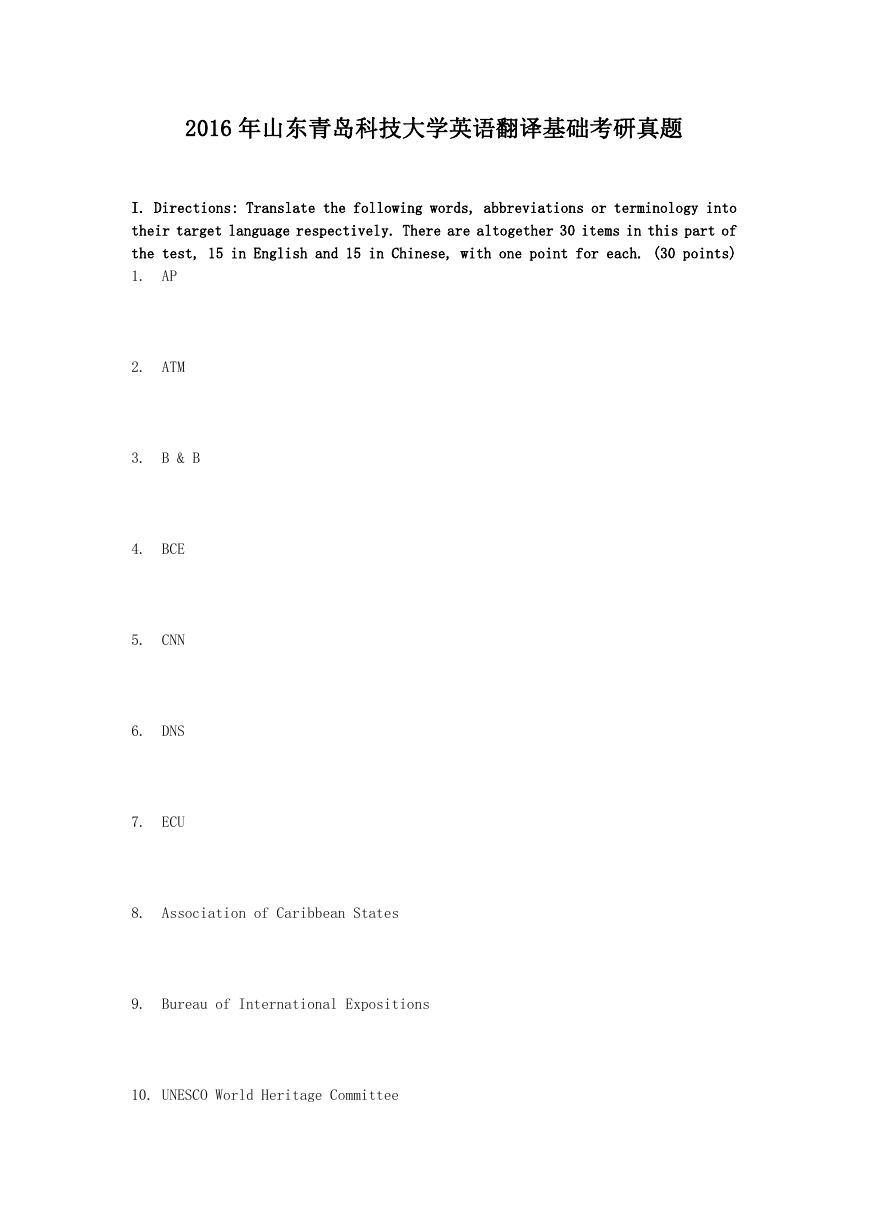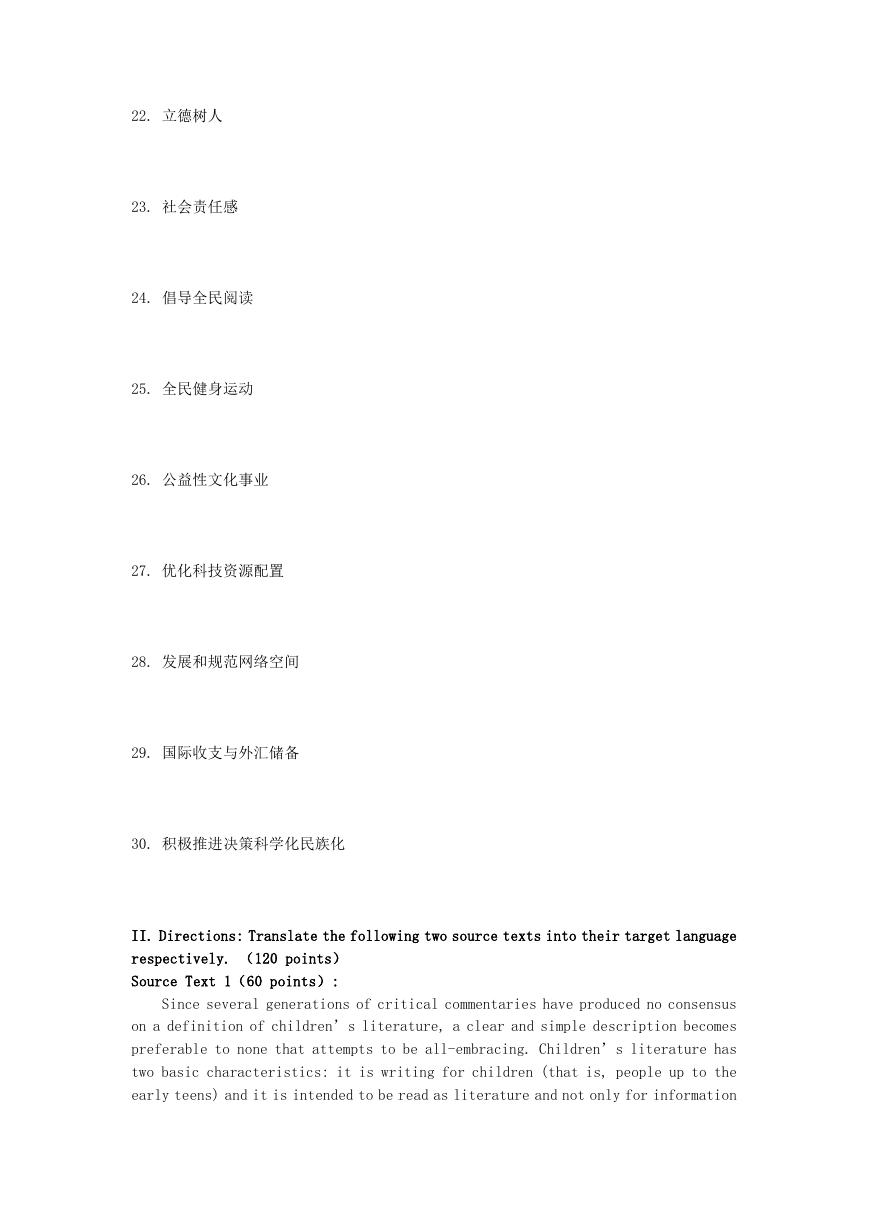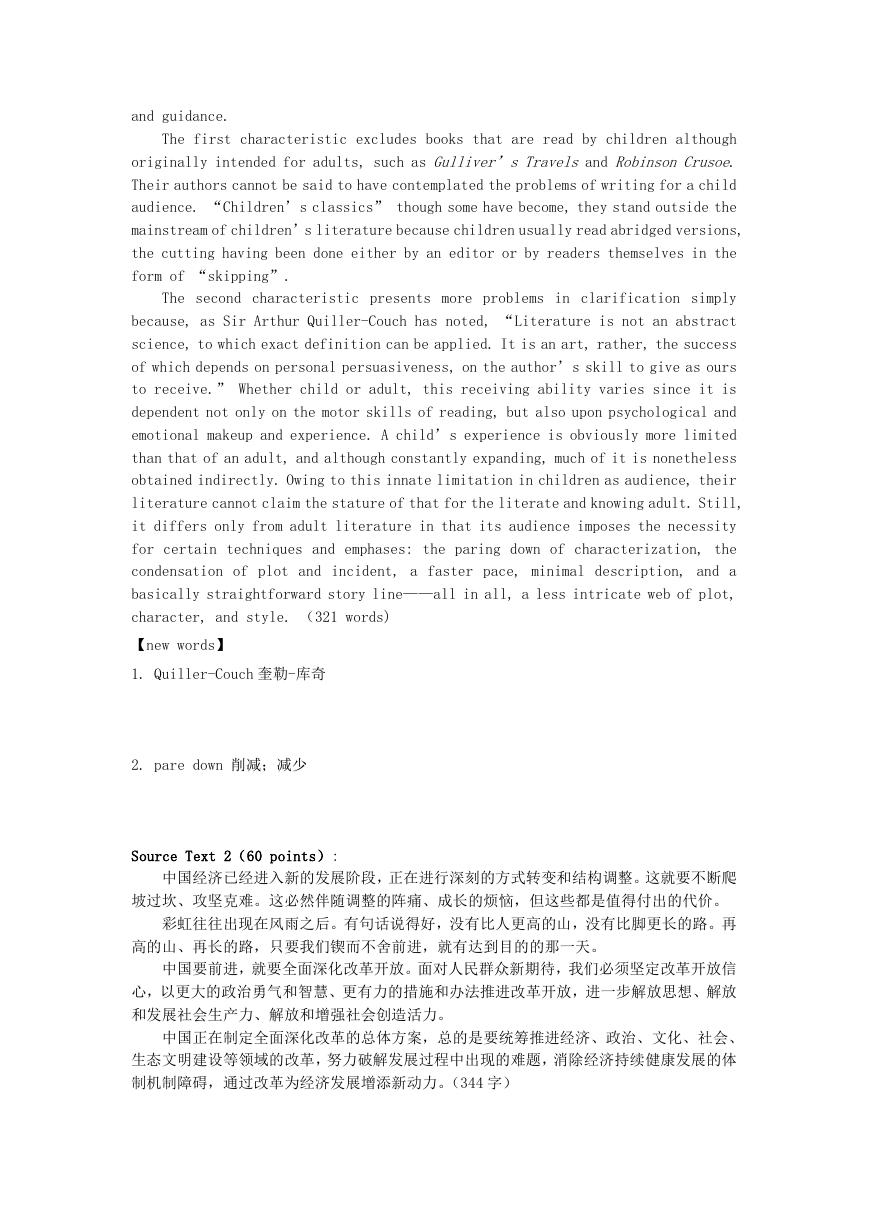2016 年山东青岛科技大学英语翻译基础考研真题
I. Directions: Translate the following words, abbreviations or terminology into
their target language respectively. There are altogether 30 items in this part of
the test, 15 in English and 15 in Chinese, with one point for each. (30 points)
1.
AP
2.
ATM
3.
B & B
4.
BCE
5.
CNN
6.
DNS
7.
ECU
8.
Association of Caribbean States
9.
Bureau of International Expositions
10. UNESCO World Heritage Committee
�
11. General Agreement on Tariffs and Trade
12. Intellectual Property Protection Treaties
13. International Association of Prosecutors
14. International Federation of Library Associations and Institutions
15. International Federation of Red Cross and Red Crescent Societies
16. 跳槽
17. 拉面
18. 黑车
19. 海选
20. 世博会
21. 亲子鉴定
�
22. 立德树人
23. 社会责任感
24. 倡导全民阅读
25. 全民健身运动
26. 公益性文化事业
27. 优化科技资源配置
28. 发展和规范网络空间
29. 国际收支与外汇储备
30. 积极推进决策科学化民族化
II. Directions: Translate the following two source texts into their target language
respectively. (120 points)
Source Text 1(60 points):
Since several generations of critical commentaries have produced no consensus
on a definition of children’s literature, a clear and simple description becomes
preferable to none that attempts to be all-embracing. Children’s literature has
two basic characteristics: it is writing for children (that is, people up to the
early teens) and it is intended to be read as literature and not only for information
�
and guidance.
The first characteristic excludes books that are read by children although
originally intended for adults, such as Gulliver’s Travels and Robinson Crusoe.
Their authors cannot be said to have contemplated the problems of writing for a child
audience. “Children’s classics” though some have become, they stand outside the
mainstream of children’s literature because children usually read abridged versions,
the cutting having been done either by an editor or by readers themselves in the
form of “skipping”.
The second characteristic presents more problems in clarification simply
because, as Sir Arthur Quiller-Couch has noted, “Literature is not an abstract
science, to which exact definition can be applied. It is an art, rather, the success
of which depends on personal persuasiveness, on the author’s skill to give as ours
to receive.” Whether child or adult, this receiving ability varies since it is
dependent not only on the motor skills of reading, but also upon psychological and
emotional makeup and experience. A child’s experience is obviously more limited
than that of an adult, and although constantly expanding, much of it is nonetheless
obtained indirectly. Owing to this innate limitation in children as audience, their
literature cannot claim the stature of that for the literate and knowing adult. Still,
it differs only from adult literature in that its audience imposes the necessity
for certain techniques and emphases: the paring down of characterization, the
condensation of plot and incident, a faster pace, minimal description, and a
basically straightforward story line——all in all, a less intricate web of plot,
character, and style. (321 words)
【new words】
1. Quiller-Couch 奎勒-库奇
2. pare down 削减;减少
Source Text 2(60 points):
中国经济已经进入新的发展阶段,正在进行深刻的方式转变和结构调整。这就要不断爬
坡过坎、攻坚克难。这必然伴随调整的阵痛、成长的烦恼,但这些都是值得付出的代价。
彩虹往往出现在风雨之后。有句话说得好,没有比人更高的山,没有比脚更长的路。再
高的山、再长的路,只要我们锲而不舍前进,就有达到目的的那一天。
中国要前进,就要全面深化改革开放。面对人民群众新期待,我们必须坚定改革开放信
心,以更大的政治勇气和智慧、更有力的措施和办法推进改革开放,进一步解放思想、解放
和发展社会生产力、解放和增强社会创造活力。
中国正在制定全面深化改革的总体方案,总的是要统筹推进经济、政治、文化、社会、
生态文明建设等领域的改革,努力破解发展过程中出现的难题,消除经济持续健康发展的体
制机制障碍,通过改革为经济发展增添新动力。(344 字)
�








 2023年江西萍乡中考道德与法治真题及答案.doc
2023年江西萍乡中考道德与法治真题及答案.doc 2012年重庆南川中考生物真题及答案.doc
2012年重庆南川中考生物真题及答案.doc 2013年江西师范大学地理学综合及文艺理论基础考研真题.doc
2013年江西师范大学地理学综合及文艺理论基础考研真题.doc 2020年四川甘孜小升初语文真题及答案I卷.doc
2020年四川甘孜小升初语文真题及答案I卷.doc 2020年注册岩土工程师专业基础考试真题及答案.doc
2020年注册岩土工程师专业基础考试真题及答案.doc 2023-2024学年福建省厦门市九年级上学期数学月考试题及答案.doc
2023-2024学年福建省厦门市九年级上学期数学月考试题及答案.doc 2021-2022学年辽宁省沈阳市大东区九年级上学期语文期末试题及答案.doc
2021-2022学年辽宁省沈阳市大东区九年级上学期语文期末试题及答案.doc 2022-2023学年北京东城区初三第一学期物理期末试卷及答案.doc
2022-2023学年北京东城区初三第一学期物理期末试卷及答案.doc 2018上半年江西教师资格初中地理学科知识与教学能力真题及答案.doc
2018上半年江西教师资格初中地理学科知识与教学能力真题及答案.doc 2012年河北国家公务员申论考试真题及答案-省级.doc
2012年河北国家公务员申论考试真题及答案-省级.doc 2020-2021学年江苏省扬州市江都区邵樊片九年级上学期数学第一次质量检测试题及答案.doc
2020-2021学年江苏省扬州市江都区邵樊片九年级上学期数学第一次质量检测试题及答案.doc 2022下半年黑龙江教师资格证中学综合素质真题及答案.doc
2022下半年黑龙江教师资格证中学综合素质真题及答案.doc